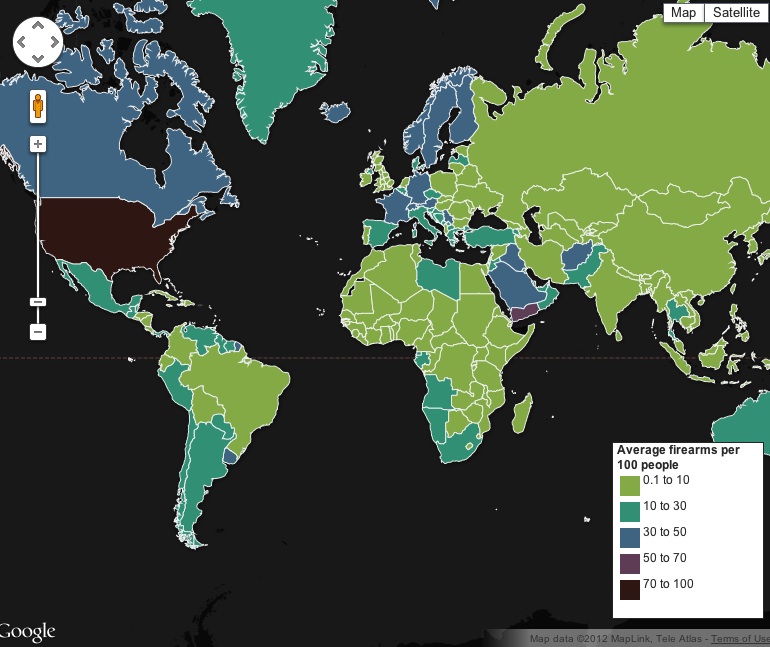The following article, “Visualizing gun deaths – Comparing the U.S. to the rest of the world,” was written by Katie Leach-Kemon and posted March 21, 2014. Dr. Leach-Kemon, a weekly contributor of global health visual information posts for Humanosphere, is a policy translation specialist from the University of Washington’s Institute for Health Metrics and Evaluation:
When it comes to gun violence, the United States stands out. President Obama’s nominee for surgeon general, Vivek Murthy, a renowned Boston-based physician, has advocated for stricter gun-control laws and referred to the U.S. rates of gun violence as a public health threat. Murthy’s views have ignited opposition from the gun lobby and politicians on both sides of the aisle, virtually assuring an end to his bid to become the U.S.’s top public health official.
In any debate about gun control and violence prevention, it is useful to examine data on gun deaths. How does the US stack up against other countries when it comes to homicides involving guns? Figure 1, which uses findings from the Global Burden of Disease Study 2010, illustrates the difference in firearm homicide rates between the US and other high-income countries. Adjusting for differences in population size, rates of homicides from guns were 6.6 times larger in the US than in Portugal, the country with one of the highest rates in Western Europe.
In a 2013 article for The Atlantic online that compared gun homicides in US cities to some of the deadliest places in the world, the authors created a map (Figure 2) that shows Atlanta has the same gun murder rate as South Africa, Detroit as El Salvador, and Phoenix equal to Mexico’s gun homicide rate. Figure 3 compares gun homicide rates in the US with countries that frequently make headlines for conflict-related violence (Afghanistan, Iraq, the Democratic Republic of the Congo, and Pakistan). The US has higher rates of homicides from guns than Pakistan. At 4.5 deaths per 100,000 people, the US rates aren’t much lower than gun homicide rates in the Democratic Republic of the Congo (5.2 deaths per 100,000 people). Annually, the US has about two fewer gun homicide deaths per 100,000 people than Iraq, which has 6.5 deaths per 100,000.
Compared to certain countries known for their high crime rates, such as Jamaica, Russia, South Africa, and Kenya, the US had the second-highest rate of gun homicide deaths after Jamaica (view data online). Although the US stands out for its high rates of homicide firearm deaths, its rates look small compared to certain Latin American countries. Figure 4 indicates that El Salvador, Colombia, and Honduras had the highest rates of firearm homicides in the world in 2010.
What can the US learn from strategies these countries are taking to address gun violence? One inspiring example comes from Cali, Colombia, and highlights the value of using data to identify risk factors for homicide. In the early 1990s, the mayor of Cali decided to use data to improve health outcomes in his city. A physician and epidemiologist by training, Dr. Rodrigo Guerrero Velasco set up a firearm death tracking system to identify different risk factors driving these trends. Guerrero Velasco and his colleagues found that more than half of Cali’s homicide victims were intoxicated. Also, analysis of the data revealed that homicides were more likely to involve young people and occur on holiday weekends, weekends following paydays, and election days.
Based on these findings, Guerrero Velasco implemented several interventions to address these risk factors, such as limiting the hours alcohol could be sold, imposing curfews for individuals under 18 on the weekends, and imposing short-term gun bans on select weekends and election days when homicides were most likely to occur. According to an academic study based on an analysis of the city’s gun death database, homicides declined from a high of 124 per 100,000 in 1994 to 86 per 100,000 in 1997 (see Figure 5). Another study published in the Journal of the American Medical Association and co-authored by University of Washington epidemiologists found that homicide death rates were 14% lower than expected during periods when gun bans were imposed in Cali.
In 2011, Guerrero Velasco was re-elected to a second term as mayor of Cali. It will be enlightening to see what additional steps he takes to curb the city’s gun violence. Instead of using local data to identify local solutions, the US may largely have to rely on studies done in other countries to gain insight into ways to curb gun violence. Even though Obama lifted a 17-year-old ban on US federal funding for gun violence research in 2013, a congressional ban on funding for this research remains in place.


.jpg)





